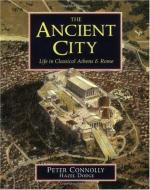
|
| Name: _________________________ | Period: ___________________ |
This test consists of 5 multiple choice questions, 5 short answer questions, and 10 short essay questions.
Multiple Choice Questions
1. Laws keeping women under the authority of her husband are _____ in early Roman history.
(a) Abolished.
(b) Passed.
(c) Upheld.
(d) Ignored.
2. The young aristocratic girls who are responsible for the sacred fire of Vesta, goddess of the hearth, are called:
(a) Vestal priestesses.
(b) Vestal Virgins.
(c) Vestal vicars.
(d) Vestal Vipers.
3. This invention helps make way for the building of the Colosseum, the Baths of Trajan and the Temple of Venus.
(a) Mortar.
(b) Cranes.
(c) Brick.
(d) Concrete.
4. The Sacra Via and the Nova Via are the only of these wide enough.
(a) Streets.
(b) Churches.
(c) Sewers.
(d) Rivers.
5. Each household has one of these, dedicated to a specific God.
(a) Cross.
(b) Outbuilding.
(c) Shrine.
(d) Room.
Short Answer Questions
1. This garment symbolizes a young man's status as a full citizen.
2. These help to organize small time businessmen of Rome.
3. Nero and his advisers blame these individuals for a great fire that guts central Rome.
4. Formal education of young women in Rome is _____.
5. This is used even in ancient Rome to access buildings during construction.
Short Essay Questions
1. Describe where Rome receives her food supply.
2. Describe the education of children in Rome. Be sure to include information about class differences, gender differences, and how the educational system was organized.
3. What is the Circus Maximus, where is it, and what is it made from?
4. Describe the theater of Pompey.
5. Explain the trials and punishments of the Roman Empire.
6. Describe the great fire, Nero's response, and his scapegoat.
7. Describe Roman marriage, including the age of marriage for both men and women, any penalties for not being married over a certain age, how they are arranged, the engagement, and the wedding ceremony.
8. Describe the reign, and fall, of Caligula.
9. Describe men and women's clothing and fashion in Rome. Be sure to include information about not only clothing, but also hairstyles, cosmetics, and any other information.
10. Explain the imperial cult, in as much detail as possible.
|
This section contains 1,042 words (approx. 4 pages at 300 words per page) |

|




